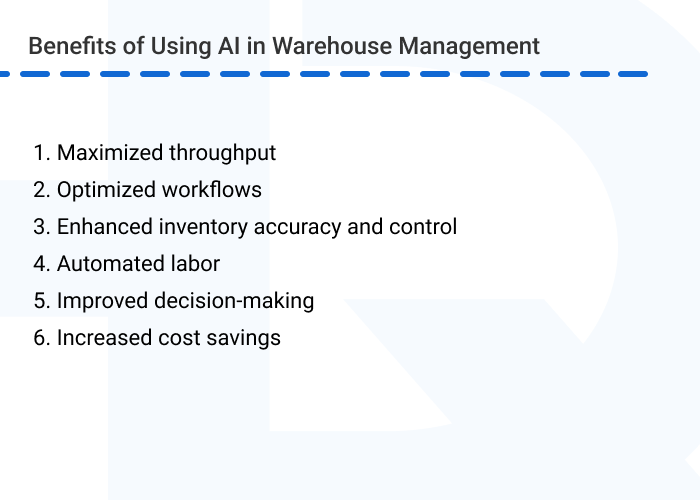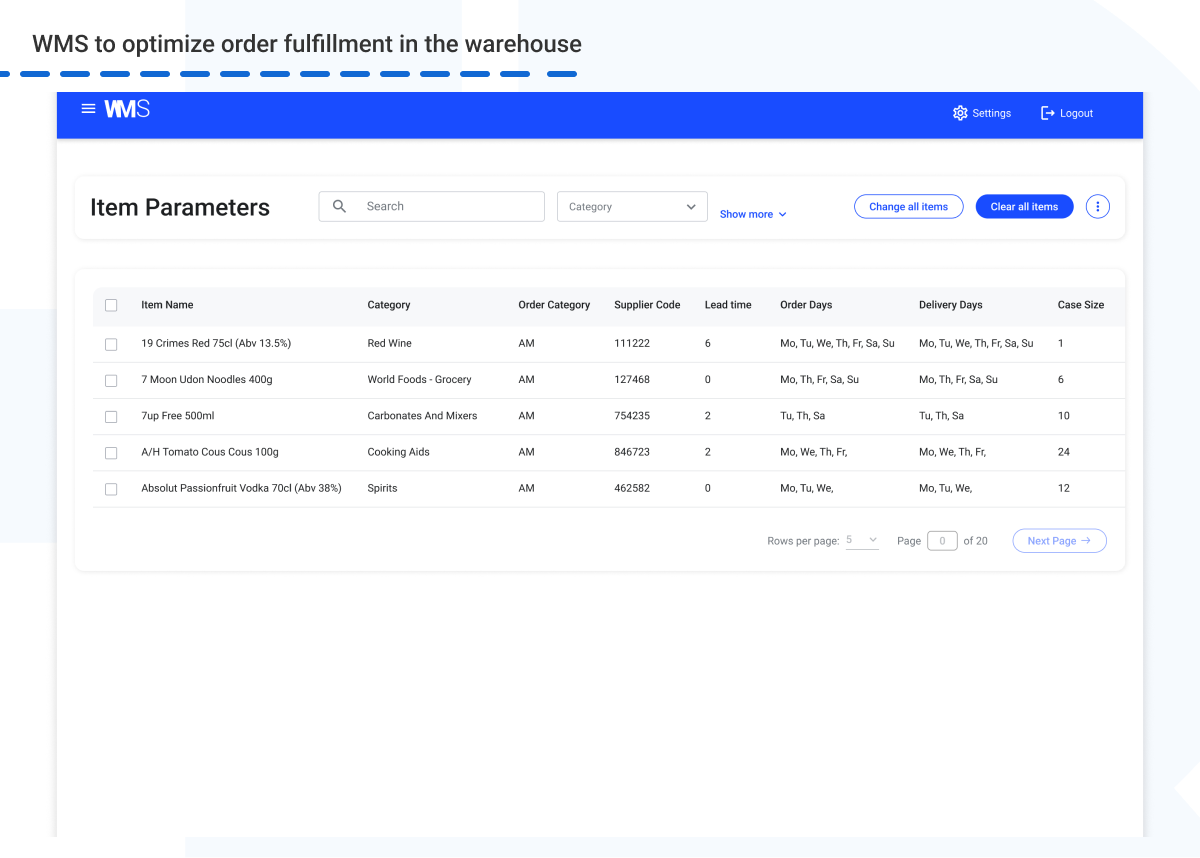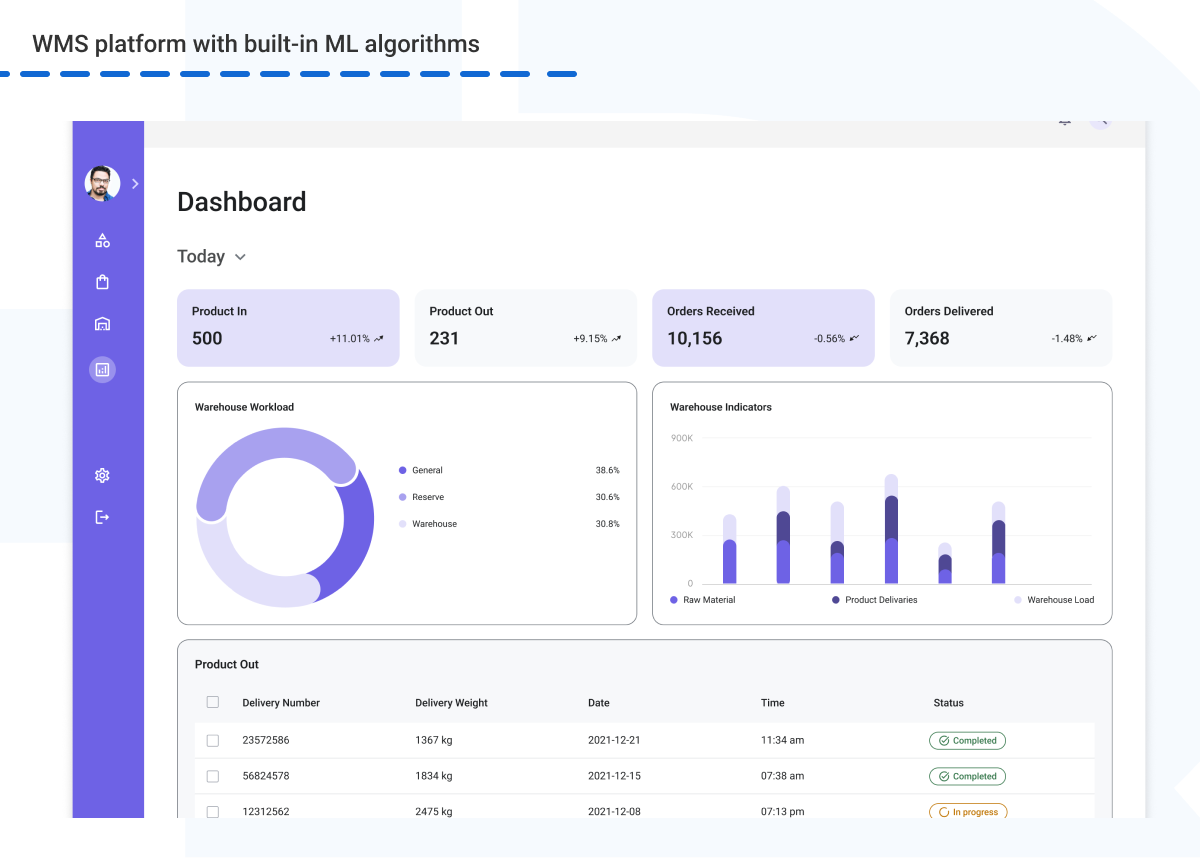Benefits of Using AI in Warehouse Management
7 AI applications in Warehouse Management Systems (WMS)
Challenges of in AI Adoption in Warehousing
To efficiently manage numerous logistics processes within modern warehouses, companies now require real-time optimization, predictive maintenance, and strategic planning. This is driving widespread adoption of Artificial Intelligence (AI) applications within the industry.
According to a report by Business Research, the global market for AI in supply chain management and logistics, which includes warehouse management, is projected to reach $16.56 billion by 2028, up from $2.84 million in 2023. Meanwhile, a survey by Zebra Technologies found that 94% of logistics companies plan to use AI in their warehouses within the next five years.
This surge reflects the increasing acquisition of AI technologies in warehouse management within the next decade. This means that computer vision, Machine Learning (ML), and predictive analytics are helping to streamline warehouse management.
In this article, we will explore how AI is enhancing warehouse management and look at some of the strategic advantages it brings to the forefront.
With workers distributing thousands of products daily to fulfill orders, mistakes are inevitable. But with Artificial Intelligence now entering the picture, warehouses are envisioning a new state of perfection — one where they will always have real-time visibility, down to each item’s precise location. However, the advantages of implementing AI in warehouse management go beyond simple inventory management, encompassing:
Overall, as warehouses implement AI-powered solutions, they gain unprecedented insights into inventory holdings, optimized workflows, and enriched fulfillment capabilities.

As AI technologies mature, their integration within warehouse management systems is redefining best practices. Let’s explore 7 core ways that AI in warehouse management is especially effective, including:
Modern warehouses require sophisticated automation to achieve peak efficiency in a complex logistics environment. Beyond simple inventory tracking or isolated order management capabilities, companies now require intelligent systems that can strategically coordinate activities across multiple locations within a centralized system.
AL algorithms have the ability to process extensive volumes of real-time facility data, including inventory levels, item locations, priority rankings, and more. Using this data, AI then can accurately predict demand, automate the order processing workflow, and compute the most efficient routes for picking items while prioritizing worker safety. For this task, the system considers factors such as minimizing walking distances and mitigating congestion in the “busiest” areas.
An example is one we have developed at HQSoftware: an AI-enabled E-3PL solution optimizing order fulfillment in the warehouse. The system can automate and optimize numerous logistics processes, some of which can be performed autonomously. For instance, it can generate replenishment orders automatically by considering customer demand forecasts, or provide real-time updates on product availability and pricing to buyers.

Beyond automating workflow tasks, the E-3PL solution enhances navigation, integrates disparate systems and accelerates fulfillment cycles. The implementation of the system demonstrates its ability to achieve over 99.9% order accuracy and same-day delivery 99.4% of the time.
Traditionally, warehouse staff would periodically conduct manual cycle counts; these are time-consuming and disruptive, resulting in inaccurate inventory data. Such an approach can lead to a cascade of problems, from stockouts and lost sales to overstocking and wasted resources.
Thanks to computer vision and AI algorithms, a “digital twin” of the physical warehouse is being created to continuously monitor shelves and detect any differences between what’s actually there versus records. This allows issues to be flagged and addressed immediately.
ML also helps identify root causes of errors. As a result, inventory accuracy is vastly improved.
Picture this: a warehouse worker with a clipboard in his hand is navigating a labyrinth of aisles, searching for specific items scattered across a vast space. Such a picking process, while familiar, is often inefficient. This is where Artificial Intelligence intermodal routing can provide a major advantage.
AI algorithms can analyze order details, warehouse layout, real-time traffic flow, and even worker availability, to determine the most efficient picking routes. This goes beyond simple shortest-path calculations. AI considers factors such as product weight, fragility, and potential congestion points, and generates optimal routes for a blended fleet of carts, conveyors, autonomous mobile robots, etc.
This way, using ML models trained on historical route data, the WMS transportation manager continuously analyzes pick completions, destination locations and vehicle capacities. As new orders arrive, routes are re-optimized on the fly.
Accurate demand forecasting ensures that warehouses can meet customer demands without overstocking or understocking, thus maintaining a delicate balance that is essential for cost-effective operations. A study by McKinsey & Company revealed that AI and advanced analytics could potentially create $2 trillion to $4 trillion in value annually across manufacturing and supply chain planning.
AI systems use ML algorithms to sift through massive datasets, including historical sales data, market trends, consumer behavior, and even broader economic indicators. By identifying patterns and correlations within this data, AI can forecast future demand with remarkable accuracy. AI algorithms, however, can analyze a much wider range of data points, including:
We have developed such a WMS platform with built-in ML algorithms at HQSoftware. By analyzing vast volumes of past sales, market and customer data, the ML models learn complex patterns that can anticipate future consumption trends with sharper accuracy. The models analyze both past and current operational data points to generate data-driven replenishment suggestions.

Recommendations consider the client’s unique supply chain parameters, for instance minimum order quantities. This helps to optimize inventory, reduce excess costs, improve space utilization and proactively respond to customer demands. As a result of the AI-powered analytics, the client has reduced their inventory holding costs by 15%.
Traditional layout approaches rely heavily on human intuition and rule-of-thumb. Artificial Intelligence, in contrast, can analyze millions of potential layout scenarios, determining the single best configuration to maximize space utilization and worker productivity. When planning optimal slotting across zones and aisles, warehouse management comprehensively considers various factors such as item weight, size, storage temperatures, pick frequencies, and more.
For example, AI in warehouses can forecast demand for different products and adjust the warehouse layout accordingly. If a particular product is expected to see a surge in demand, AI can preemptively position it closer to the shipping area, ensuring swift and efficient fulfillment. Such a level of foresight not only enhances operational efficiency but also enables warehouses to better manage labor and resources.
Unplanned downtime in warehouses can be hugely disruptive and costly. Now advanced AI is bringing new predictive ability to equipment maintenance programs.
By monitoring operational performance metrics from motor drives, conveyors, sorting systems and more, anomaly detection algorithms learn each asset’s normal functioning parameters. Subtle deviations that would go unnoticed to human eyes serve as early warning signs of impending issues. AI proactively flags anomalies to maintenance teams before failures occur.
Automated monitoring dashboards within the WMS interface give managers a virtual ‘X-ray’ view of the entire facility from any location. They can pinpoint congested areas, bottlenecks or absent staff with the touch of a button.
Leading WMS providers are pairing advanced monitoring cameras with AI algorithms. Through continual image recognition training, the AI develops an unparalleled ability to identify inventory, equipment, workers and interactions on the floor.
Some vision systems even generate predictive analytics, using AI to recognize patterns and proactively warn of potential issues. For example, early signs of a machine malfunction could trigger automated maintenance alerts.
Overall, by leveraging AI technologies, warehouses can achieve superior efficiency, productivity, and accuracy in their operations. However, the journey towards AI adoption in warehousing is not without its challenges.
Need a custom software solution? We’re ready to help!HQSoftware has a team of skilled professionals ready to tackle the project. Ask me!
Natallia Rudzik
Business Development Manager
Having developed numerous WMS projects enriched with AI functionality, we can identify the following aspects to be considered and addressed.
Data management. AI systems thrive on high-quality data to make accurate predictions and decisions. However, warehouses often struggle with managing vast amounts of data, which can include inconsistencies, errors, and incomplete information.
How to address: Implement a centralized data management system that integrates data from various sources within the warehouse, such as inventory systems, order management systems, and sales data. This ensures that data is consolidated and accessible in a unified format.
Integration with existing systems. Many warehouses have legacy systems in place, making it challenging to incorporate AI technology seamlessly. Moreover, AI must be able to communicate with other systems, such as transportation management systems, to provide a unified solution.
How to address: Conduct a thorough assessment of the existing systems in the warehouse to identify their capabilities, limitations, and compatibility with AI technology. Such an evaluation helps determine the extent of integration required and potential areas for improvement.
Cybersecurity risks. As warehouses become more connected through AI and IoT technologies, they may be exposed to increased cybersecurity risks.
How to address: Implement multi-factor authentication and stringent access controls to ensure that only authorized personnel can access sensitive data and systems, to reduce the risk of data breaches.
To sum up, the promise of AI-powered warehouse management is clear: increased efficiency, reduced costs, and improved customer satisfaction. But how do you actually get started?
Remember, implementing Artificial Intelligence is a journey, not a destination. By following these steps, you can successfully embrace AI and unlock its transformative potential for your warehouse operations. Here’s a step-by-step guide to implementing AI in the warehouse:
By carefully selecting a development partner, you’ll have a strong foundation for building and implementing AI solutions that meet your specific needs.
Considering custom software?HQSoftware’s team of experts can design and develop the perfect solution for your business. Let’s discuss it
Dmitry Tihonovich
Business Development Manager
At HQSoftware, we provide a comprehensive data management platform that helps warehouses overcome inconsistencies, errors and gaps in their data.
Whether it’s ERP, WMS, TMS or other operational tools, our experts ensure AI-powered insights can be seamlessly incorporated without disruption. By leveraging open standards and offering out-of-the-box connectors, we minimize the effort required to incorporate advanced analytics while still honoring existing technology investments — delivering the benefits of a fully integrated, end-to-end intelligent warehouse solution.
By embedding security at each layer and process, from infrastructure to application, we enable warehouses to leverage advanced technologies with the assurance that critical assets and data remain protected.
As both data volumes and Machine Learning techniques continue to advance rapidly, the coming decades will see automation taken to new frontiers. A survey by Honeywell found that 48% of retail industry leaders believe Artificial Intelligence will be a competitive differentiator for their organizations in the next five years.
Predictive analytics, among other key trends, play the main role in optimizing operations. AI-powered forecasting, demand prediction and equipment monitoring help warehouses proactively anticipate needs, preempt issues and optimize key levers such as inventory levels and maintenance scheduling, for improved efficiency and customer fulfillment.
Increasingly sophisticated AI-driven robotics systems that use machine vision, sensors and autonomous navigation are taking on more complex tasks at higher speeds. Collaborative robots working collaboratively with humans are also gaining popularity in warehouses to enhance both productivity and worker safety.
Digital twins and simulation models are also growing in importance for designing optimal warehouse layouts, flow processes and capital investments before physical implementation. These techniques facilitate informed planning by allowing for testing using virtual scenarios and identifying bottlenecks.
Contact us to discuss how we can help you enhance your WMS solution with AI.

HQSoftware Founder
Having founded the company in 2001, uses his broad knowledge to drive the company forward. Ready to share his wisdom on software development and technology insights